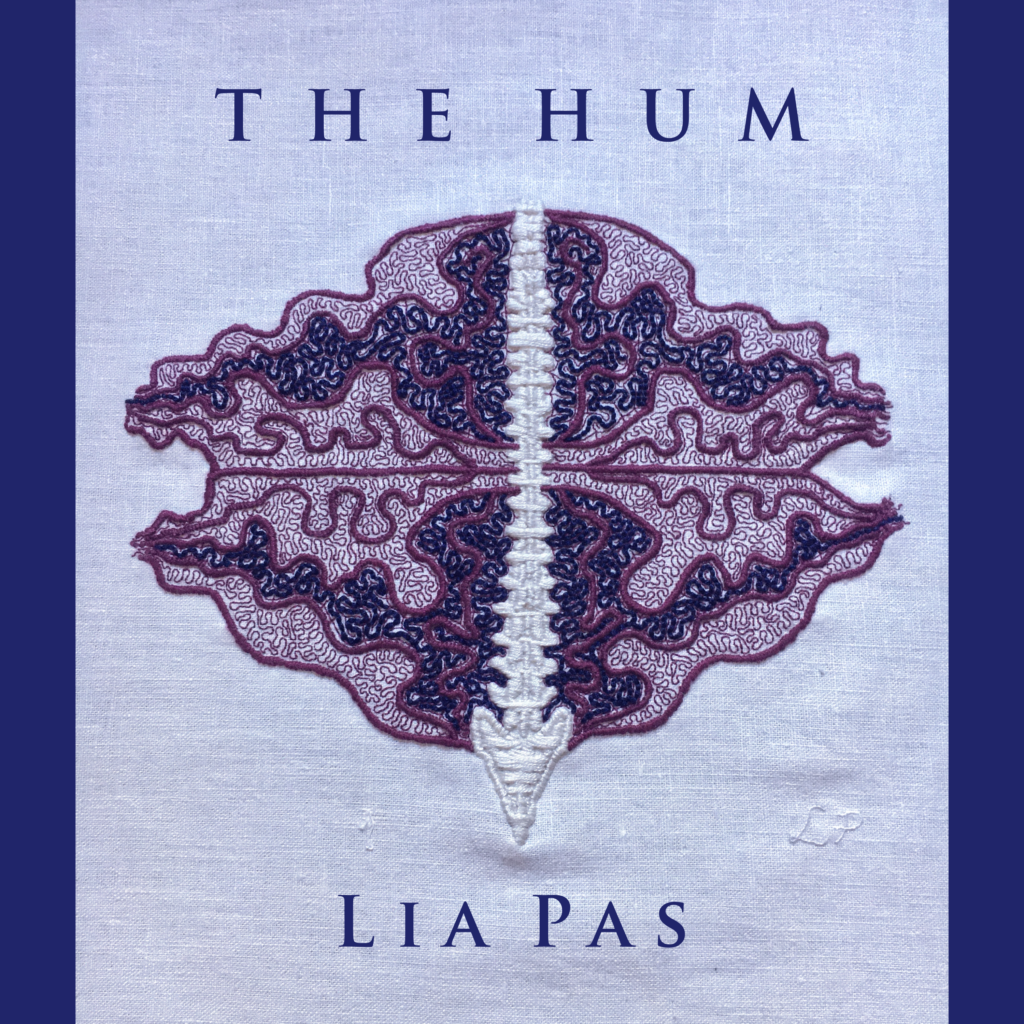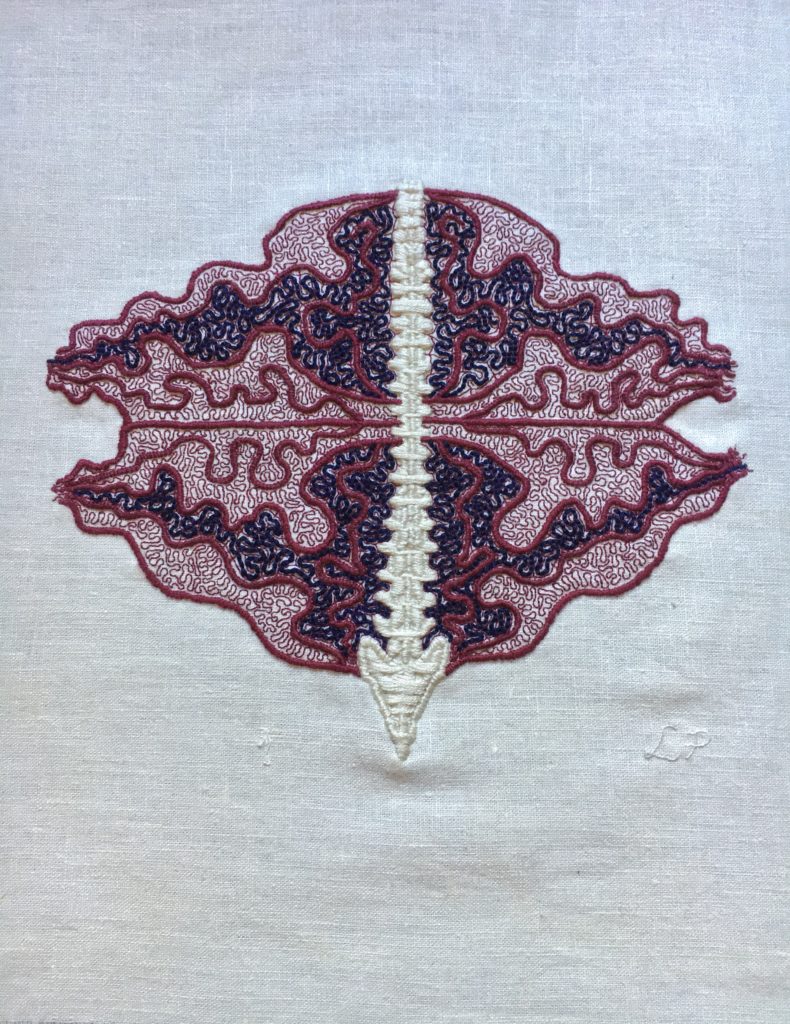
I have completed The Hum—a piece of music based on my hyperacusis and tinnitus symptoms. It’s just over 11 minutes long, and is a calm, ambient, and somewhat minimalist piece. Here is a 1 minute, 20 second taste of the recording:
You can buy the entire 11 minute recording on my Ko-fi page as an mp3.
Read on for more information about my long and gentle music reintegration and composition process for this piece.
My Return to Music
This is the first piece of music I’ve completed since the onset of myalgic encephalomyelitis/chronic fatigue syndrome (ME/CFS) in 2015. If you’re more familiar with my embroidery work you may not know that I was primarily a composer/performer for 25 years until I became suddenly disabled by a virus. I was working on a dance opera with La Caravan Dance Theatre at the time. I was unable to perform as planned because I was so sick I was unable to even bathe myself regularly at first.
That dance opera—Fihi ma Fihi, It is What it is—did get performed a few months after I fell ill. Here is one of my personal favourite pieces from it:
The first couple years of being sick are a bit of a fog to be honest. I wasn’t able to sit up unsupported so playing piano was impossible and I definitely couldn’t—and still can’t—sing. I even lent my piano keyboard to a friend for a few months because it was sitting unused in my studio.
The hallmark symptom of ME/CFS is post-exertional malaise (PEM). When I overextend myself physically or cognitively all my neuroimmune symptoms are exacerbated. PEM doesn’t always occur right after the “energy insult”, but can happen as long as 48 hours afterwards. It is imperative I stay within my energy envelope to avoid PEM because it could potentially cause me to lose what functionality I have regained.
At some point, maybe in 2017?, I began to have enough energy to sit up unsupported for short periods and decided to begin a very cautious experiment in playing piano again.
Playing the piano is physical, cognitive, and sensory. Any one of those states can result in PEM if I overextend within them so rebuilding my practice required gentleness with a large dose of caution. I started with one minute on days where I had good energy and slowly added a minute at a time over a number of months whenever it felt possible. This allowed me to slowly yet consistently come back to playing music. I started with Hanon exercises to rebuild the muscles in my hands, then introduced some scales to refamiliarize my brain with the concept of different keys, then added some simple sight reading to retrain myself to read music again. It was only once I had the basics back that I began relearning Satie’s Three Gymnopedies. They are slow and simple enough that I could take my time with each one. Then, and only then, I added improvisation back in.
In the past, my composition practice was a blend of improvising musical ideas and writing down what I heard in my head. As part of my music reintegration process I wrote a simple piano piece for my niece and found the written part of my composition skills had mostly disappeared. It was then that I decided to lean into my improvisation practice more so I didn’t have to worry about notation, instead writing down my general ideas in words with a few phrases or chords notated as a general guideline.
Hyperacusis
Throughout this long process I was also dealing with severe hyperacusis. Hyperacusis isn’t well known and hence isn’t well understood. When people think of sound sensitivity, they usually think of misophonia. Misophonia is an emotional response to certain sounds, driven by the amygdala. The sounds people react to are very specific—chewing, wrappers crinkling, nails on a chalkboard—and almost always evoke a feeling of annoyance or anger.
Hyperacusis is a hypersensitivity to ALL sounds, and the reaction is felt by the entire autonomic nervous system (ANS). When triggered by sound—volume, timbre, and vibration are all factors—symptoms can be absolutely debilitating and are widely varied. My hyperacusis causes brain fog, cognitive fatigue, tension headaches, and myalgia (the sort of all over ache one gets with a fever). I can hear and sense sounds that most people are unaware of. Construction in our neighbourhood, even a couple blocks away, is especially symptom-inducing.
One of the more disconcerting symptoms I have is I can hear a constant quietish low- to tenor-pitched hum. I’m still unsure if I’m just sensing the sound of the city around me or if it is another manifestation of internal tinnitus. The hum is more obvious on days with high humidity and I can sometimes feel the vibration of it through walls, floors, and furniture, so it feels like it must be coming from outside my body.

My embroidery piece, sensorium is about this type of sensory hypersensitivity so I decided to use it for the album cover of The Hum.
When people experience hyperacusis, it might seem obvious to use earplugs to block out the trigger sounds. However, the cause of this type of sensitivity is in the ANS, so blocking out the sound doesn’t deal with the root cause and can actually make hyperacusis and tinnitus much worse. What is needed is to calm the ANS while slowly building up a tolerance for sounds which is a long, slow, and delicate process in my experience.
Reintroducing Sound
One of the main sound desensitization tools that I still use daily is masking sounds. These are sounds that are matched in pitch to the trigger sounds but they have a soothing instead of activating effect on the nervous system. Pink and brown noise are especially helpful in my experience, especially when the hum I hear is louder than usual. The sonic complexity of pink and brown noise is similar to sounds in nature such as our internal body sounds, rain falling, waterfalls, and ocean waves. I have a speaker playing brown noise under my bed at night and shift the volume depending on my symptoms.
Even more effective than pink and brown noise are recordings of nature sounds themselves since they are so much more complex. My favourites are thunderstorms, especially with frogs or crickets in the background, since that combination masks both the hyperacusis hum and my high pitched tinnitus.
I had been using masking sounds for a while when I was introduced to Stephen Porges’ Safe and sound Protocol (SSP). The protocol is designed to retrain the ANS to be calm when exposed to sound. From what I understand, it is primarily meant for autistic people to more easily engage with the human voice so the desensitization includes only that range of pitches. I did find the protocol very helpful overall, even if it didn’t address the low-pitched sounds I am most sensitive to. The protocol was also an excellent experiential introduction to polyvagal theory, which I am currently learning more about to manage my other symptoms and as research for a large embroidery piece.
After the SSP I was able to start listening to more music in general, though I found I needed to listen to ambient and/or calming pieces to start. I listened to a lot of Brian Eno’s Music for Airports as well as Arvo Pärt and Marconi Union. Music can also work as a masking sound. One piece I listen to on especially symptomatic days is John Luther Adams’ Become Ocean. It is a wall of sound that has the ability to wash over me and calms my ANS almost immediately.
Composition Process
Both Become Ocean and Arvo Pärt’s music were big influences on The Hum. The Hum masks my hyperacusis and tinnitus in terms of pitches, but is also calm and ambient enough to soothe my ANS. I started by choosing which sounds to layer as drones, masking my hyperacusis hum, then improvised piano lines over top, using my tinnitus pitch as the tonic pitch. The last and surprisingly longest step was editing the dynamics of the various layers of drones so that they would support the piano line without overwhelming it, but also feel organic enough so the listener can relax into the layers.
If you would like a short taste of the piece you can listen to it here:
And if you would like to purchase the mp3, it is available for $2 CAD on my Ko-fi.
